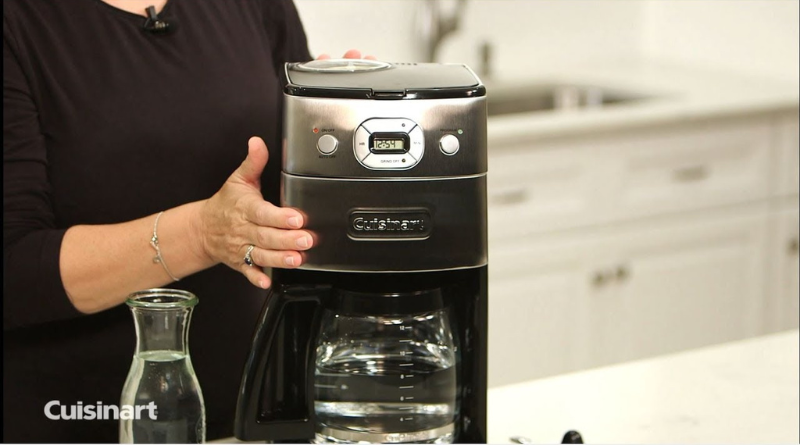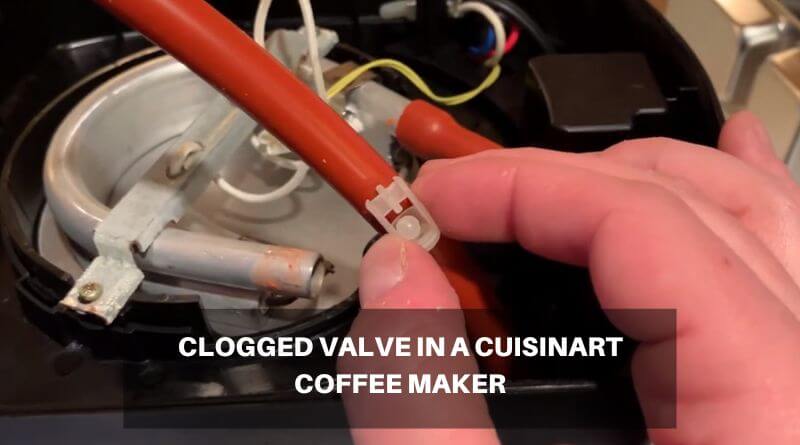Hey there! This post contains affiliate links to products. We may receive a commission for purchases made through these links. But it never influences our product selection process.
As with any machine, Cuisinart coffee makers sometimes encounter issues. One common problem is a Cuisinart coffee maker clogged valve. Thus, it can disrupt the brewing process and affect the quality of your coffee. Let’s learn how to fix them.
Usually, mineral buildup, coffee grounds residue, or worn parts can cause a Cuisinart coffee maker’s clogged valve. To fix this issue, Descale the machine using vinegar or a descaling solution first. Then, clean the valve area carefully. Also, clean your coffee maker regularly and avoid very fine ground coffee.
Here, I’ll discuss the causes and prevention of valve clogs and methods for addressing and preventing them. As a result, you can enjoy uninterrupted brewing and rich, flavorful coffee every time.
If your Nespresso machine not making a full cup. To resolve this issue, follow the troubleshooting steps outlined in this blog.
7 Signs of a Clogged Valve In a Cuisinart Coffee Maker

For that perfect cup of coffee, you need a well-functioning coffee maker. It’s disappointing when your beloved Cuisinart starts producing weak brews or stops working. So, you should check if the problem is a clogged valve before panicking.
Here are seven signs that indicate my Cuisinart coffee maker is clogged:
Slow Brewing Time:
If your Cuisinart coffee maker’s brewing time is significantly longer, it may be experiencing valve clogging. The valve may block if the water takes longer than usual to pass through the coffee grounds and into the carafe. It can result in weaker or bitter-tasting coffee as well.
Inconsistent Water Flow:
Another telltale sign of valve clogging is inconsistent water flow during brewing. You may notice that water sometimes spurts out sporadically or stops flowing altogether. An uneven extraction of flavors can result in an imbalanced and subpar-tasting coffee.
Leaking Around the Valve Area:
Observe for any leaks around the valve area of your Cuisinart coffee maker. There may be a problem with valve clogging if you see puddles or drips during and after brewing. Blockages or debris within the valve can disrupt its sealing capabilities, resulting in unwanted leaks.
Reduced Brewing Capacity:
Valve clogging can also impact the overall brewing capacity of your Cuisinart coffee maker. Debris blocking the valve is likely causing the reduced flow, even if you use the same amount of water and ground beans.
Slow Drip or No Drip:
A slow or no drip is one of the most obvious signs of valve clogging in a Cuisinart coffee maker. If your coffee is taking longer than usual to brew or is not coming out, it may indicate a blockage in the valves. You must address this issue as soon as possible, as it can hurt the taste and quality of your coffee.
Gurgling Sounds:
Another sign of valve clogging is gurgling from the coffee maker. It occurs when air bubbles are trapped in the system due to blockages in the valves. Besides affecting the performance of your coffee maker, this is also an early warning sign.
Uneven Extraction:
Clogged valves may distribute water unevenly throughout the grounds, resulting in uneven extraction. It means some parts of your coffee will be over-extracted while others will be under-extracted. As a result, you may notice that your brew tastes weak and lacks flavor consistency.
Cuisinart Coffee Maker Clogged Valve [Causes and Solutions]

A well-deserved cup of coffee becomes a distant dream as the machine sputters and fails to supply the caffeine. Fortunately, I’ve identified the six most common culprits behind valve clogging, so you can resolve this issue.
So grab your mug and let’s dive into the world of valve clogs in Cuisinart coffee makers!
Causes 1: Mineral Deposits
One of the most common causes of valve clogging in a Cuisinart coffee maker is the buildup of mineral deposits. Tap water contains minerals like calcium and magnesium, which can accumulate over time and block the valves.
Solution:
Regular descaling is essential to prevent mineral deposits from clogging the valve in your Cuisinart coffee maker. Follow these steps:
Use a descaling solution (commercial or homemade) to remove mineral deposits.
- Empty Reservoir: Ensure the coffee maker is unplugged and cool, then empty the reservoir.
- Fill Reservoir: Pour the descaling solution into the reservoir to the indicated level.
- Run Cycle: Start the coffee maker without grounds, letting the solution run through.
- Rinse: Discard the solution, rinse the reservoir, and refill it with clean water.
- Flush: Run a brewing cycle with clean water to flush out the remaining solution.
- Repeat if Needed: If deposits persist, repeat the process as necessary.
- Preventive Maintenance: Use filtered or distilled water and descale every 1-3 months.
- Follow Manual: Refer to your user manual for specific instructions.
Causes 2: Coffee Grounds
Cuisinart coffee maker clogged with grounds is another culprit. While a properly functioning coffee maker should filter out most grounds, some can still enter the brewing system. Over time, these grounds can accumulate and obstruct the valves, leading to poor or uneven extraction.
Solution: Unclog the Cuisinart coffee maker.
You can try these fixes to resolve the issue:
- Use your coffee maker’s recommended coffee grind size to minimize fine particles.
- Ensure you use the correct filters that prevent grounds from entering the brewing system.
- Regularly clean the filter basket and ensure no residual grounds are left after brewing.
- Inspect and clean the valve area to remove any accumulated coffee grounds.
- Occasionally, run a water-only brewing cycle without coffee grounds to help flush out any trapped grounds.
- Follow the manufacturer’s cleaning schedule and guidelines to prevent buildup.
Causes 3: Problematic Filters
The quality of the coffee filters used in a Cuisinart coffee maker also plays a significant role in valve clogging. Inferior or poorly designed filters may not be able to trap small particles effectively, allowing them to flow through and cause clogs in the valves. It’s important to use high-quality filters suitable for your specific machine model.
Solution:
There is no doubt that coffee filters can impact valve clogging. To address this issue, consider the following points:
- Use Recommended Filters: Always use filters the manufacturer recommends for your specific Cuisinart coffee maker model.
- Quality Matters: Opt for high-quality filters designed to effectively trap coffee grounds and prevent them from entering the brewing system.
- Double Check Compatibility: Ensure your filters are compatible with your coffee maker’s design and brewing mechanism.
- Inspect Filters: Before each use, inspect the filter for any tears or damage that might allow grounds to pass through.
- Proper Placement: Ensure the filter is placed correctly in the filter basket to prevent any gaps where grounds could escape.
Causes 4: Valve or Seal Failure
The valves and seals within the coffee maker can deteriorate or become damaged. It can lead to improper functioning and potential clogs.
Solutions:
If you suspect that faulty valves or seals are causing clogs and improper functioning in your Cuisinart coffee maker, here are some solutions you can consider:
- Regularly inspect and clean valves and seals.
- Replace damaged or deteriorated parts promptly.
- Perform regular descaling to remove mineral buildup.
- Use soft or filtered water to reduce mineral accumulation.
- Follow the recommended maintenance schedule.
- Handle valves and seals gently to avoid damage.
- Ensure proper alignment and secure placement.
- Periodically replace rubber seals.
- Consider professional servicing for persistent issues.
Causes 5: Excessive Oils
Coffee beans contain natural oils released during brewing. If these oils build up inside the brewing system over time, they can stick to the valves and create obstructions. Regular cleaning and maintenance are essential to prevent this type of valve clogging.
Solutions:
Indeed, the accumulation of coffee oils can lead to valve clogging. To mitigate this issue, consider the following steps:
- Clean the coffee maker’s internal components, including the valve area, regularly to prevent the buildup of coffee oils.
- Follow the manufacturer’s recommended cleaning instructions and frequency to ensure thorough maintenance.
- Occasionally, use a vinegar and water solution to clean the coffee maker’s internal parts, including the valve, to help dissolve and remove oils.
- Periodically run water-only brewing cycles to help flush out any residual oils and prevent buildup.
- Limit flavored syrups or additives that can contribute to oil buildup.
- Ensure all parts are properly dried after cleaning to prevent moisture from promoting oil adhesion.
Causes 6: Improper Cleaning
A less obvious reason for valve clogging could be related to improper cleaning practices. Refraining from regular cleaning or thoroughly rinsing all parts after descaling can lead to residue buildup inside the machine, including on the valve itself. Therefore, following the manufacturers’ instructions for cleaning and maintenance procedures is essential.
Solution:
Improper cleaning practices can contribute to valve clogging. Here’s how to avoid this issue:
- Establish a consistent cleaning schedule for your coffee maker, including the valve area.
- After descaling or cleaning, ensure all parts, including the valve, are thoroughly rinsed to remove any residue.
- Stick to the cleaning products and methods recommended by the manufacturer to ensure effective cleaning without damaging the machine.
- Pay attention to often overlooked areas, such as the valve and its surroundings, to prevent residue buildup.
- Ensure the coffee maker is unplugged and cooled down before cleaning to ensure safety.
- Follow the manufacturer’s cleaning and maintenance instructions closely to prevent issues.
Note: Poorly maintained internal components can contribute to valve clogging. Cleaning routinely can prevent bacteria and mold growth, hindering water flow. Remove leftover brewed coffee from the reservoir and clean the filters.
How To Clean A Cuisinart Coffee Maker Clogged Valve – Step-by-Step Guide
Here’s a step-by-step guide to cleaning a clogged valve in your Cuisinart coffee maker:
Essentials Elements:
- White vinegar or a commercial coffee maker descaling solution
- Water
- Soft brush or cloth
- Paper towel
Step 1: First, turn off and unplug your Cuisinart coffee maker. Empty the water reservoir and remove any remaining coffee grounds from the filter basket.
Step 2: Make a solution by mixing white vinegar with water in equal parts. Alternatively, follow the instructions on a commercial coffee maker descaling solution for the proper mixture.
Step 3: Fill the water reservoir to the maximum line with the cleaning solution. Place an empty carafe under the coffee maker’s drip spout.
Step 4: Make a pot of coffee by turning on the coffee maker and initiating a brew cycle. Let the machine run until half the cleaning solution has passed through the system. Then, turn off the coffee maker.
Step 5: The coffee maker sits for 30 minutes with the cleaning solution inside. It will help break down mineral deposits and coffee oils that are clogging the valve.
Step 6: Allow the coffee maker to finish brewing. The remaining cleaning solution will continue to clean the internal components.
Step 7: After the cleaning cycle, empty the carafe and thoroughly rinse it with water. Refill the water reservoir with clean water. Run a brewing cycle with clean water to flush out any remaining cleaning solution.
Note: If the Breville cleaning cycle isn’t functioning properly, it may be due to issues like blocked tubes or sensor problems. For detailed solutions and guidance, click this link: Breville cleaning cleaning cycle not working
Step 8: While the coffee maker is still warm, use a damp cloth or sponge to wipe the exterior surfaces. Dry the coffee maker with a clean, dry cloth.
Step 9: Inspect the valve area for any remaining clogs or debris. Use a soft brush or cloth if you notice any to gently clean the valve and surrounding area.
4 Alternative Methods for Unclogging a Cuisinart Coffee Maker Valve
If you are in the frustrating situation of having a clogged valve in your beloved Cuisinart coffee maker, don’t panic just yet. Clean your machine using alternative methods instead of calling a professional.
Air Compressors Method:
Air compressors or canned air dusters are also effective for unclogging Cuisinart coffee maker valves. You can start by unplugging your machine and removing any remaining liquid from the reservoir.
By using compressed air, release the valve without damaging delicate components. It restores proper flow and functionality by removing debris from machine valves.
Soda And Lemon Juice Method:
Another alternative method involves using baking soda and lemon juice. Create a mixture with two tablespoons of baking soda and one cup of lemon juice. Scrub gently with an old toothbrush or cloth after applying this paste directly to the clogged valve area. Rinse your coffee maker multiple times afterward to ensure no mixture traces remain.
Toothpick Technique:
Without any cleaning solutions on hand, try poking the valve opening gently with a toothpick. Sometimes, coffee residue can build up in this area, obstructing proper flow. Don’t push too hard or use anything sharp that could damage the valve mechanism. With some patience and gentle poking, you may be able to dislodge any clogs and restore normal function.
Hot Water Method:
Run hot water through the system to unclog a stubborn valve for a simpler solution. Fill up your coffee maker’s reservoir with hot water (not boiling). After 15 minutes, run a few brewing cycles without grounds.
Note: If necessary, consult your specific Cuisinart coffee maker model’s user manual before attempting these alternative methods.
Preventive Measures to Avoid Valve Clogs
These are some preventive measures you can take to avoid valve clogs in your Cuisinart coffee maker:
- Use filtered or soft water to reduce mineral buildup.
- Regularly descale the coffee maker using a recommended descaling solution.
- Clean the coffee maker’s internal components, including valves and seals, according to the manufacturer’s instructions.
- Ensure proper coffee ground filtration using the correct filter size and not overpacking the filter basket.
- Avoid using very fine coffee grounds that can easily clog the system.
- Check and replace rubber seals periodically to prevent deterioration.
- Follow the recommended maintenance schedule outlined in the user manual.
- Be gentle when handling and cleaning valves and seals to prevent damage.
- Store the coffee maker in a dry and clean environment when not in use.
Frequently Asked Questions (FAQs):
Why is my Cuisinart coffee maker not dispensing?
If your Cuisinart coffee maker isn’t dispensing, it could be due to clogged water lines or a blocked valve. Check for mineral buildup or debris. Then, clean the machine thoroughly, and ensure proper water flow before brewing.
Can I run vinegar through my Cuisinart coffee maker?
You can use a vinegar solution to descale and clean your Cuisinart coffee maker. Mix equal parts white vinegar and water, and run a brewing cycle. Then follow up with several cycles of clean water to remove any vinegar taste.
Why does my Cuisinart coffee maker keep overflowing?
Your Cuisinart coffee maker might overflow due to excessive water or coffee grounds. Ensure proper water level and coffee ground measurements. Finally, check for clogs in the filter basket or brewing system.
Why won’t my coffee filter drain?
A coffee filter might not drain due to fine-grind coffee blocking, improper filter placement, or clogs. Ensure a suitable grind size, and correct filter positioning, and clean the filter basket regularly.
Why is there water on top of my portafilter after brewing?
There needs to be more portafilter locking, uneven coffee tamping, or worn gaskets to prevent water from getting on top of the portafilter. Ensure proper tamping, a suitable grind, and secure locking. Also, check for worn components.
My Opinion:
Nothing is more frustrating and inconvenient than a Cuisinart coffee maker clogged valve. Following these simple steps, you can restore a smooth, uninterrupted brewing experience. But if you want to make the perfect cup of coffee every day, you must take care of your machine.
Remember to regularly clean your coffee maker and descale it to prevent future clogs. So, don’t let a clogged valve ruin your morning routine. Take action today and get your Cuisinart coffee maker back in top shape!





